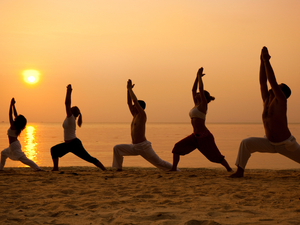The Risks And Rewards Of Practicing Yoga : NPR

February 7, 2012
Twenty million people practice yoga in the United States. William Broad, a Pulitzer Prize-winning science writer for The New York Times, is one of them. Broad started doing yoga as a freshman in college in 1970 and has been practicing ever since.
"I can't imagine doing [my] job without it," he tells Fresh Air's Terry Gross. "It's an excellent means of stress management. Yoga helps me relax. And that's the thing that most yogis swear by. No matter how poorly you do it or how stressed you are, you're going to get this guaranteed de-stressing, relaxing, anti-civilization effect of yoga — which is wonderful."
Broad's new book, The Science of Yoga, investigates both the risks and rewards of yoga. Using the latest scientific research, Broad explains the benefits of yoga, while debunking the myths surrounding it and explaining why certain yoga moves can even be quite dangerous.
"There are [poses] that really bend your neck a lot," he says. "The shoulder stand, the plow, those kind of things. You're rotating your neck around 90 degrees, and it turns out that there are delicate arteries that run through your neck called vertebral arteries. And if they get tweaked around too much ... and you're unlucky, you can tear the lining of the arteries, you can have clots, and you get up from that pose or you're in the middle of a pose — and those clots move into the brain, and you've got brain damage. Some people even die."
Those extreme injuries are rare, says Broad. More commonly, people hurt their lower backs, shoulders, knees and necks.
"It's mostly complex joints where people have problems," he says. "You have dislocations and tears, ligaments and all kinds of nasty stuff. It's a wide range, but generally you're not just talking about torn muscles — you're talking about joint problems in one way or another."
Not Used To Knot-Tying Poses
Part of the reason we get injuries, he says, is that we sit in offices all day and aren't used to the knot-tying poses.
"It just doesn't work, especially if you have an inexperienced teacher, a teacher who may be gifted [or] a teacher who may be genetically predisposed to flexibility and may think that everybody should be that flexible," he says. "And they aren't. Guys aren't. Guys tend to be stiffer than women. ... I try to start tying myself in knots like [the women in my class] and it doesn't work."
Broad says that until recently, many yoga teachers were in denial about the potential downsides of yoga. But that's improved, he says, and there are dozens of groups working to make the practice of yoga safer — and better.
"[Groups] are using props to ease the poses," he says. "They use blankets with the shoulder stand to decrease the angle, so your neck isn't flexed at 90 degrees. ... Dozens of groups are out there refining poses, doing smart things. ...
The Risks And Rewards Of Practicing Yoga

iStockphoto.com Five people on a beach stand in the warrior pose.
"I can't imagine doing [my] job without it," he tells Fresh Air's Terry Gross. "It's an excellent means of stress management. Yoga helps me relax. And that's the thing that most yogis swear by. No matter how poorly you do it or how stressed you are, you're going to get this guaranteed de-stressing, relaxing, anti-civilization effect of yoga — which is wonderful."
Broad's new book, The Science of Yoga, investigates both the risks and rewards of yoga. Using the latest scientific research, Broad explains the benefits of yoga, while debunking the myths surrounding it and explaining why certain yoga moves can even be quite dangerous.
"There are [poses] that really bend your neck a lot," he says. "The shoulder stand, the plow, those kind of things. You're rotating your neck around 90 degrees, and it turns out that there are delicate arteries that run through your neck called vertebral arteries. And if they get tweaked around too much ... and you're unlucky, you can tear the lining of the arteries, you can have clots, and you get up from that pose or you're in the middle of a pose — and those clots move into the brain, and you've got brain damage. Some people even die."
Those extreme injuries are rare, says Broad. More commonly, people hurt their lower backs, shoulders, knees and necks.
"It's mostly complex joints where people have problems," he says. "You have dislocations and tears, ligaments and all kinds of nasty stuff. It's a wide range, but generally you're not just talking about torn muscles — you're talking about joint problems in one way or another."
Not Used To Knot-Tying Poses
Part of the reason we get injuries, he says, is that we sit in offices all day and aren't used to the knot-tying poses.
"It just doesn't work, especially if you have an inexperienced teacher, a teacher who may be gifted [or] a teacher who may be genetically predisposed to flexibility and may think that everybody should be that flexible," he says. "And they aren't. Guys aren't. Guys tend to be stiffer than women. ... I try to start tying myself in knots like [the women in my class] and it doesn't work."
Broad says that until recently, many yoga teachers were in denial about the potential downsides of yoga. But that's improved, he says, and there are dozens of groups working to make the practice of yoga safer — and better.
"[Groups] are using props to ease the poses," he says. "They use blankets with the shoulder stand to decrease the angle, so your neck isn't flexed at 90 degrees. ... Dozens of groups are out there refining poses, doing smart things. ...

No comments:
Post a Comment